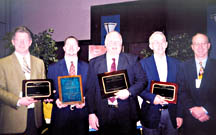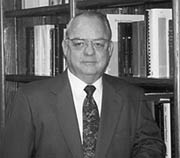Review: The University of Southern Mississippi's Twenty-Ninth Annual Waterborne, High-Solids, and Powder Coating Symposium

The presentations were all extraordinarily well done, but certain topics and papers will be briefly discussed. Dr. Shelby F. Thames kicked off the symposium with an introduction to The University of Southern Mississippi, which is located in Hattiesburg, MS. He described the heritage of the university and of the conference. Dr. Thames described the educational institution, faculty, and students as well as the role these play in the coating and polymer science world.
Combinatorial chemistry or high throughput screening are among the many names applied to the technique of rapidly screening large numbers of samples. The technique holds promise for shortening development times, for decreasing the time to bring technological breakthroughs to fruition, and to yield enormous increases in productivity in the coating industry. The pharmaceutical industry first applied this technology about two decades ago with great success. Today one pharmaceutical company claims to be able to screen as many as 200,000 drug candidates per day. Two papers that dealt with this topic were presented at the symposium. One paper explained the technique, how it is used in the pharmaceutical industry, and how it applies to the coating industry. The other paper was concerned with a particular combinatorial method that was devised for development of a clear coating for plastic substrates. The highly automated process had the capability of evaluating 100-200 coatings per day. Coatings were prepared, applied, and cured. Then they were evaluated for optical clarity, abrasion resistance, and adhesion. Computer software, including a database, was used for data management and storage. The technique enhanced the rate of product development. There was strong conference attendee interest in the presentations as evidenced by numerous questions that were well answered by the presenters.
Conversion coatings are important to impart corrosion resistance to high-strength aluminum alloys that are useful in the aircraft industry and elsewhere. They contribute to the structural stability of the airplanes that are flown by the airlines, military, and privately. An interesting paper dealt with cerium-based conversion coatings as possible replacements for the chromate systems that are in use today. Chromates are one of the 17 most toxic substances on the EPA list of hazardous materials, and chromium may be eliminated from the workplace in the near future. The cerium-based coatings under development are non-toxic in nature, and they can be applied to aluminum surfaces by means of electrolytic and spontaneous methods such as spray, immersion, etc. Results of the study were presented along with a proposed mechanism for the deposition/treatment process. A companion paper was concerned with the mechanism of protection and complexation of cerium inhibitor salts with the polymeric coating.
Surfactants of various types were a popular topic in this year's conference. These compounds provide various functions in the coating process and are essential to latex formation. However, after the final coating is formed, they may be detrimental to long life due to water sensitivity. There were presentations that dealt with self-crosslinking dispersants, highly active cationic wetting and dispersing additives, non-migratory surfactants, polyether modified polydimethylsiloxanes for improved wetting as well as flow and leveling, and halogenated additives as dispersants in waterborne coatings. The goal of some of these surfactants was to alleviate or eliminate the water sensitivity caused by the residual surfactants in the final film.
Other interesting topics, and there are too many to mention all, were concerned with improved scratch and mar resistance in automotive coatings (three papers); architectural coatings containing methyl silicone polymers and dimethylamino-functional polysiloxane for stain resistance; new non-lead organic pigments; surface treatments on mica to improve humidity resistance of pearlescent pigments; soybean oil - a renewable resource - based polyurethanes as well as hyperbranched soy alkyd polymers for low VOC coatings; and the list could go on and on.
The Shelby F. Thames Best Paper Award of $10,000 went to Dr. J.W. Taylor and Dr. T.D. Klots of Johnson Polymer for their elucidation of film formation in waterborne industrial coatings. The investigators coupled basic and applied technology to describe film formation. They invoked glass transition temperature, minimum film formation temperature, diffusion, distribution and activity coefficients as well as other information in a mathematical way to describe the process of film formation.
The fifth year of the Technology Showcase provided an added attraction. Twenty companies or technical societies participated in the Showcase. This multi-day event that made information about materials, technologies, services, and equipment available was presented in an exhibit-style format to interested individuals. In addition, the Showcase provided an excellent informal, convivial format for conference attendees to interact, share ideas, and discuss "old times." It was readily apparent that all enjoyed it. Also enjoyed by attendees were two evening events. One of these was a Mardi Gras-themed reception sponsored by Eastman Chemical Co. and an After-Dinner Coffee and Desserts event sponsored by OSi Specialties. For those interested, a schedule of the early evening Mardi Gras parades was provided.
Laura Fosselman and her staff, including University of Southern Mississippi students, handled on-site administrative details of the conference. Their helpfulness and attention to detail were important to the success of the conference and made everyone's attendance more pleasant.

Noted Coatings Educator Shelby Thames Named President of University
By Joe Maty / Senior Editor HATTIESBURG, MS - Shelby Thames, noted coatings scientist, longtime university professor and administrator and driving force behind the highly respected Annual Waterborne, High-Solids and Powder Coatings Symposium, was recently appointed president of the University of Southern Mississippi.
Thames, who held the title of distinguished Research professor of Polymer Science before accepting the university's presidency, is the eighth president in the history of USM. Thames was chosen for the position following a seven-month, nationwide search process conducted by the university board.
Thames, a Hattiesburg native, has been a USM professor, department chairman, dean, and vice president during a 37-year career with the university. He joined the faculty as an assistant professor of Chemistry in 1964 and founded the Polymer Science Department in 1970. He spearheaded a campaign for federal funding that led to the 1991 construction of USM's $19.7-million Polymer Science Research Center, later named in his honor. He guided development of the Polymer Science Department into the School of Polymers and High Performance Materials; helped create the complementary Mississippi Polymer Institute; and laid the groundwork for a graduate program that is ranked among the nation's best by U.S. News and World Report, the university said. The School of Polymers and High Performance Materials is considered one of the top polymers and coatings educational and research institutions in the nation.
Thames and then-USM colleagues Gary Wildman and George Bufkin teamed up to launch the Waterborne, High-Solids and Powder Coatings Waterborne Symposium in 1973. The symposium, held annually in New Orleans, showcases emerging low-VOC coatings research and is considered one of the most influential coatings-technology conferences worldwide.
Always interested in the development of environmentally friendly polymers and coatings based on natural materials, Thames has led a 50-member "green research" team called the Thames Research Group. The group recently developed a vegetable-oil-based, no-VOC paint that will be used by the U.S. Defense Department to paint the interior walls of the Pentagon. Thames also founded Southern Diversified Products L.L.C. to manufacture and sell the paint, with USM to benefit from royalties. Thames plans to remain active with the research group.
Thames earned a bachelor's degree in organic chemistry and master's degree in chemistry from USM and a doctorate in organic chemistry from the University of Tennessee.
Looking for a reprint of this article?
From high-res PDFs to custom plaques, order your copy today!





